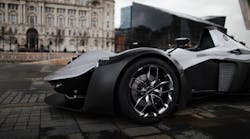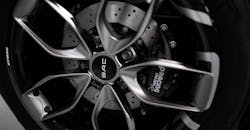The beauty of generative design is the ability to effectively look at what’s possible, especially as manufacturers explore future development opportunities. After all, the ability to review a few hundred designs provides evidence needed to make informed decisions. Although having a lot of designs can be overwhelming, after filtering out low-performance designs, expensive designs or heavy designs, it does not take long to quickly narrow choices down to just a handful of options. Manufacturers can then explore the designs in the context of what can be done using current tooling versus how changing tooling or investing in a technology like additive can make a difference.
However, when Autodesk and Briggs Automotive Company (BAC) teamed up to create new wheels for its latest vehicle, it was effectively putting the capabilities of generative design to test on applying generative design. Why? The approach moved beyond looking at the usual benefits of faster time-to-design, weight reduction, and performance differentiations when considering manufacturing methods and materials.
“We applied generative design in a very new way by adding the dimension of aesthetic variation to meet a certain brand identity that would align wheel design with the rest of the vehicle,” says Andy Harris, principal technical consultant with Autodesk.
The big challenge, according to Harris was “how to define aesthetics, and how do we get the computer to understand the aesthetics we require,” he says. “Generative design is very good at giving you performance, mass, and cost. We had to give the solution a direct steer in a certain direction to generate designs that would be around an aesthetic requirement.”
“For BAC, generative design was a way to further our pursuit of the most optimized lightweight and structurally efficient parts possible,” Ian Briggs, design director and co-founder of BAC Mono tells IndustryWeek. “Our engineers were able to see what is possible structurally, using that to guide their production solution and our designers were excited to use the resulting forms as inspiration for future aesthetic styles”
Generative design is a lot like a design exploration process enabling manufacturers to reduce the amount of effort required in the concept stage. "What we want to do is provide the software with design and engineering requirements (loads, materials, manufacturing methods), and it will start to generate multiple designs," says Harris.
BAC historically leveraged a three-axis machine for their forged wheels. However, they wanted to explore how five-axis machining or additive could impact performance. “We try to explore all of the options to provide a really informed decision. It allows you to understand the cost versus the performance benefit and start making trade-offs as part of the process,” says Harris. “Once you've got all those designs and you've gone through the exploration process based on the performance mass or cost balance of those of you, and you download the chosen design as a CAD model that's ready to edit.”
The results produced a wheel that was an impressive 35% lighter, weighing 2.2 kg (or 4.85 lbs) per wheel, that could be manufactured traditionally on a CNC mill. It also met stringent structural requirements required for approval and certification in Europe. This was achieved in less time than BAC had ever designed a wheel before. The wheel design was accomplished with multiple companies efficiently working together. AutoDesk’s cloud-based Fusion 360 allowed everyone to access the files, make changes and conduct needed analysis and quickly provide feedback. BAC then went on to manufacture the first prototypes to validate what generative design provided. And those are the ones that went on the vehicle.
“Whilst it’s great to see what’s structurally possible, we are often confronted by solutions that are very expensive to realize. The fact that the manufacturing method can now be selected meant we could relevant results rather than idealized, this is a great improvement,” says Briggs. “Of course, the engineer still makes some adjustments on the outputs. It is a collaboration between the machine and the designer. Having said that, we are at the start of a new technology and we at BAC are proud to play a small part in the development process.”











